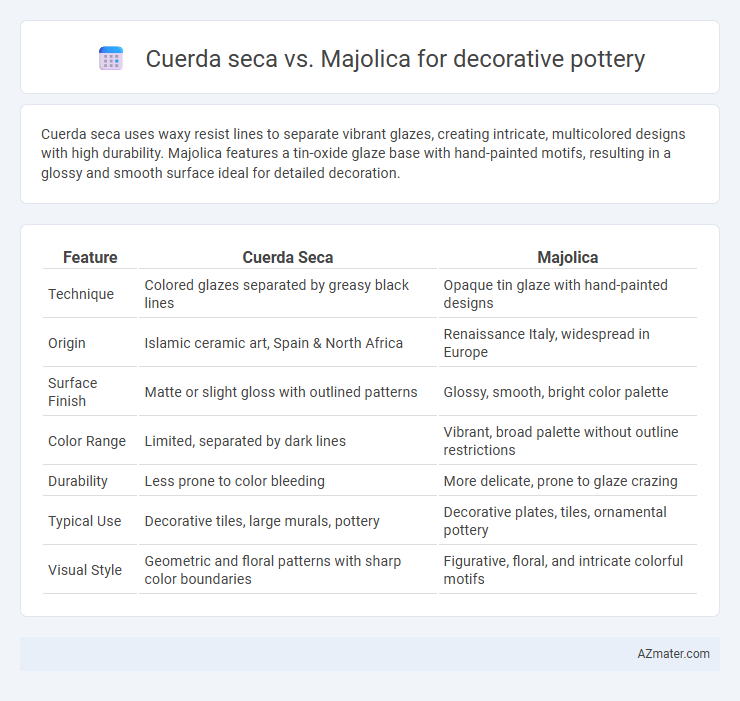Cuerda seca uses waxy resist lines to separate vibrant glazes, creating intricate, multicolored designs with high durability. Majolica features a tin-oxide glaze base with hand-painted motifs, resulting in a glossy and smooth surface ideal for detailed decoration.
Table of Comparison
| Feature | Cuerda Seca | Majolica |
|---|---|---|
| Technique | Colored glazes separated by greasy black lines | Opaque tin glaze with hand-painted designs |
| Origin | Islamic ceramic art, Spain & North Africa | Renaissance Italy, widespread in Europe |
| Surface Finish | Matte or slight gloss with outlined patterns | Glossy, smooth, bright color palette |
| Color Range | Limited, separated by dark lines | Vibrant, broad palette without outline restrictions |
| Durability | Less prone to color bleeding | More delicate, prone to glaze crazing |
| Typical Use | Decorative tiles, large murals, pottery | Decorative plates, tiles, ornamental pottery |
| Visual Style | Geometric and floral patterns with sharp color boundaries | Figurative, floral, and intricate colorful motifs |
Understanding Cuerda Seca: An Overview
Cuerda seca, a traditional pottery technique originating from Moorish Spain, involves using a greasy resist line to separate colored glazes during firing, creating intricate, multi-colored designs without color bleeding. This method contrasts with majolica, which applies tin-glazed earthenware decorated with colorful brushwork on a white opaque surface. Understanding cuerda seca's unique resist lines and glazing process reveals its distinct visual texture and durability in decorative pottery compared to the fluid, painterly style of majolica.
What is Majolica? Key Characteristics
Majolica is a tin-glazed pottery technique that features a white, opaque glaze providing a bright, glossy surface ideal for vibrant decorative patterns. This method allows for detailed, multicolored designs painted directly onto the unfired glaze, resulting in a durable and water-resistant finish popular in Mediterranean ceramic art. Key characteristics include its smooth, glossy texture, intricate hand-painted motifs, and a characteristic white background that enhances color brilliance.
Historical Origins: Cuerda Seca and Majolica
Cuerda Seca and Majolica are two distinct decorative pottery techniques with rich historical origins. Cuerda Seca originated in the Islamic world during the 10th century, characterized by using greasy lines (usually manganese oxide) to separate colored glazes, preventing them from mixing during firing. Majolica, emerging in Renaissance Italy around the 15th century, involves tin-glazed earthenware painted with vibrant colors on a white background, historically influenced by Islamic pottery but developed into a uniquely European ceramic style.
Techniques: Cuerda Seca vs Majolica Application
Cuerda Seca technique uses oil-based resist lines to separate different colored glazes, preventing mixing and allowing intricate designs with sharp outlines ideal for decorative pottery. Majolica application involves applying tin glaze to the pottery surface, then painting colorful motifs over the opaque white layer before firing, creating vibrant and glossy finishes. Both methods require precise control but Cuerda Seca excels in detailed pattern separation while Majolica emphasizes rich, uniform color coverage.
Color and Glaze Differences
Cuerda seca pottery features vivid, distinct colors separated by dark, grease-based lines that prevent color bleeding, resulting in sharp, defined patterns ideal for intricate designs. Majolica employs a tin-glazed surface producing a glossy, smooth finish where colors blend softly beneath the glaze, creating a vibrant yet uniform appearance. The key difference lies in cuerda seca's segmented color application versus majolica's continuous, lustrous glaze that enhances color depth and luminosity.
Decorative Styles and Artistic Variations
Cuerda seca technique involves using a greasy resist to separate colors, creating sharp, intricate lines that define detailed, multicolored patterns often seen in traditional Islamic and Mexican pottery. Majolica, also known as tin-glazed pottery, features a smooth, glossy surface allowing for broader, painterly artistic variations with vibrant, opaque colors and fluid brushstrokes typical of Renaissance and Mediterranean styles. Decorative styles in cuerda seca emphasize precision and complexity, while majolica prioritizes expressive, lush surfaces with artistic flexibility.
Durability and Practical Uses
Cuerda seca pottery features a resist technique using oily wax lines that create well-defined patterns with fewer chances of glaze mixing, resulting in durable, chip-resistant surfaces ideal for functional decorative pieces like tiles and wall art. Majolica pottery employs a tin-glaze base that produces vibrant colors but tends to be more brittle and prone to chipping, making it better suited for ornamental objects rather than items subject to heavy use. Both styles offer unique aesthetic appeal, but cuerda seca demonstrates superior durability and practicality for everyday decorative applications.
Popularity in Modern Decorative Pottery
Majolica enjoys greater popularity in modern decorative pottery due to its vibrant, glossy glazes and intricate painted designs that appeal to contemporary aesthetics. Cuerda seca, characterized by its distinct black line separation and subdued color palette, remains favored in traditional and artisanal contexts but is less widespread in mainstream decorative markets. The durability and vivid color range of Majolica make it a preferred choice for decorative pieces in homes and public spaces today.
Cost and Collectability Comparison
Cuerda seca pottery typically involves a more labor-intensive glazing technique, often resulting in higher production costs compared to Majolica, which uses a simpler tin-glaze process. Collectors tend to value Cuerda seca pieces for their intricate designs and rarity, driving higher market prices, while Majolica is appreciated for its vibrant colors and accessibility, generally commanding lower but steady demand. Evaluating both cost and collectability, Cuerda seca ceramics often represent a more exclusive investment, whereas Majolica offers affordability with moderate collectible appeal.
Choosing Between Cuerda Seca and Majolica
Choosing between Cuerda seca and Majolica for decorative pottery depends on the desired visual effect and durability. Cuerda seca offers intricate, separated colored patterns with a distinct black line, ideal for detailed, high-contrast designs, while Majolica provides a smooth, glossy surface with vibrant, blended colors suitable for traditional, bright motifs. Consider Majolica's ease of mass production and durability versus Cuerda seca's labor-intensive process and unique textured finish when selecting the best technique for your project.

Infographic: Cuerda seca vs Majolica for Decorative pottery
 azmater.com
azmater.com